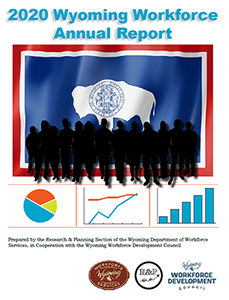Demographics and Earnings of Persons Working in Wyoming
by County, Industry, Age, & Gender, 2000-2020
Table of Contents | Introduction | Definitions | Home
Tables by Industry, County, Age, & Gender, 2000-2020 (Excel)
Published June 2021.
Introduction
The number of individuals working in each industry or county are based on employers’ quarterly wage and employment reports to the Unemployment Insurance (UI) tax section of the Wyoming Department of Workforce Services; these are referred to as wage records. UI covered employment represents approximately 91.5% of Wyoming’s total wage and salary employment. Any individual who had wages in Wyoming at any time from 2000 to 2020 is included in the summary counts presented in this research. Each individual is counted only once (see Definitions).
Research & Planning (R&P) was able to identify demographic information, such as age and gender, by linking the Wage Records database with other administrative databases, such as the driver's license file from the Wyoming Department of Transportation.


.svg)
 Wyoming at Work
Wyoming at Work